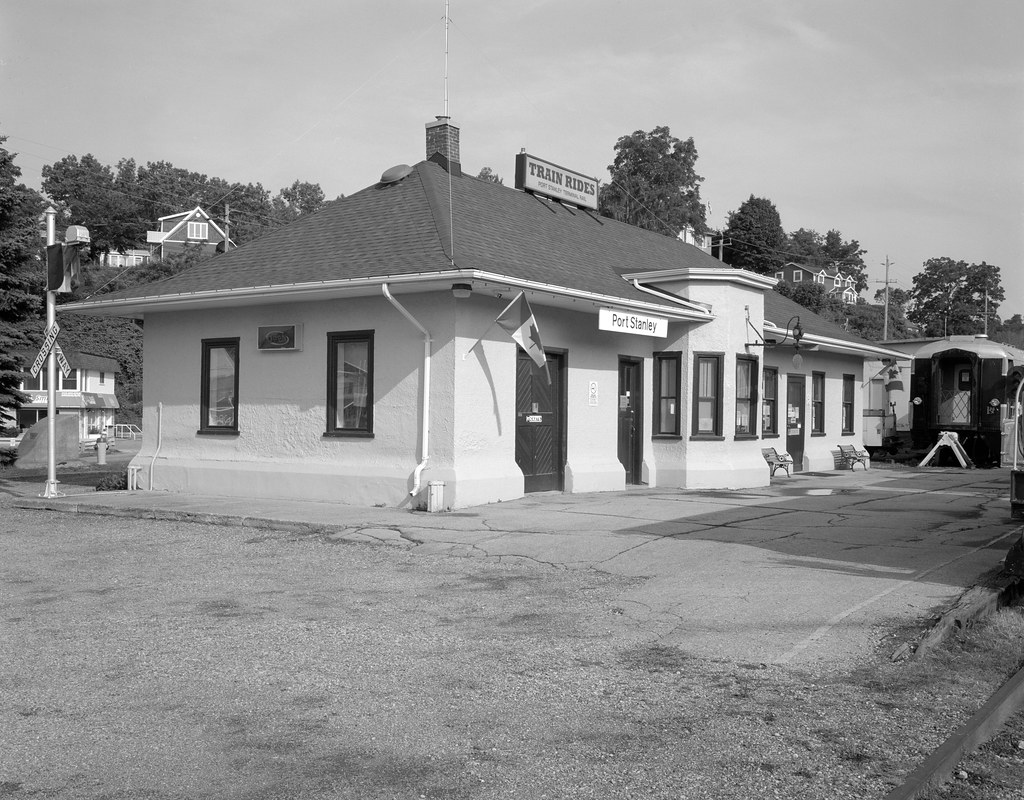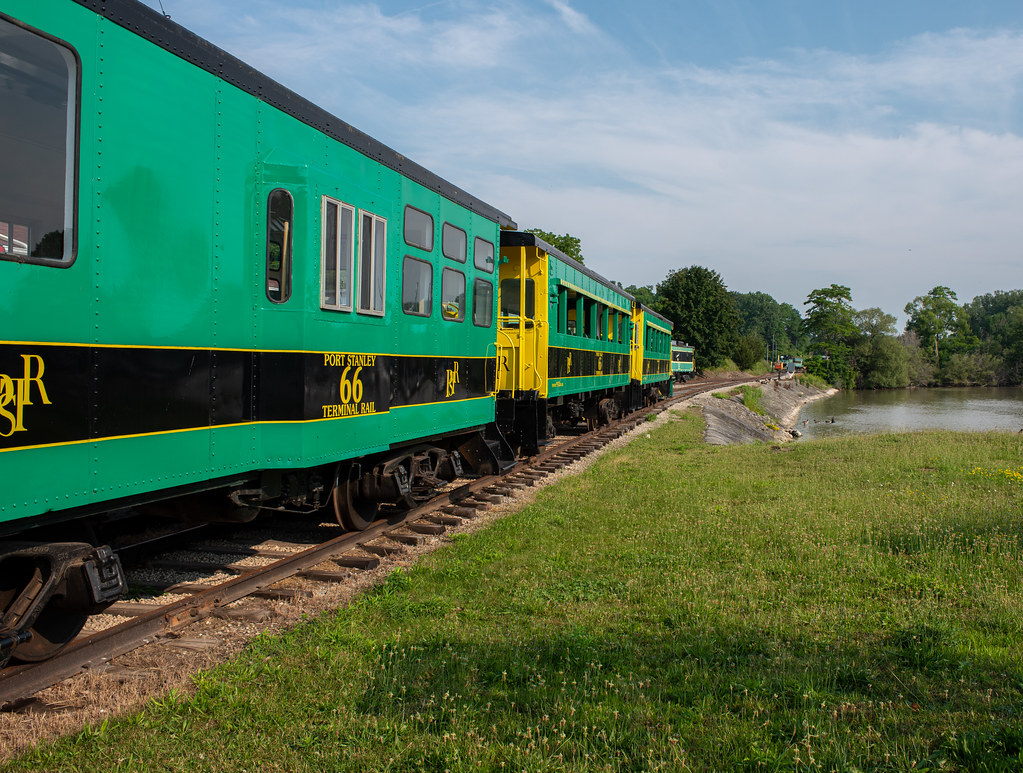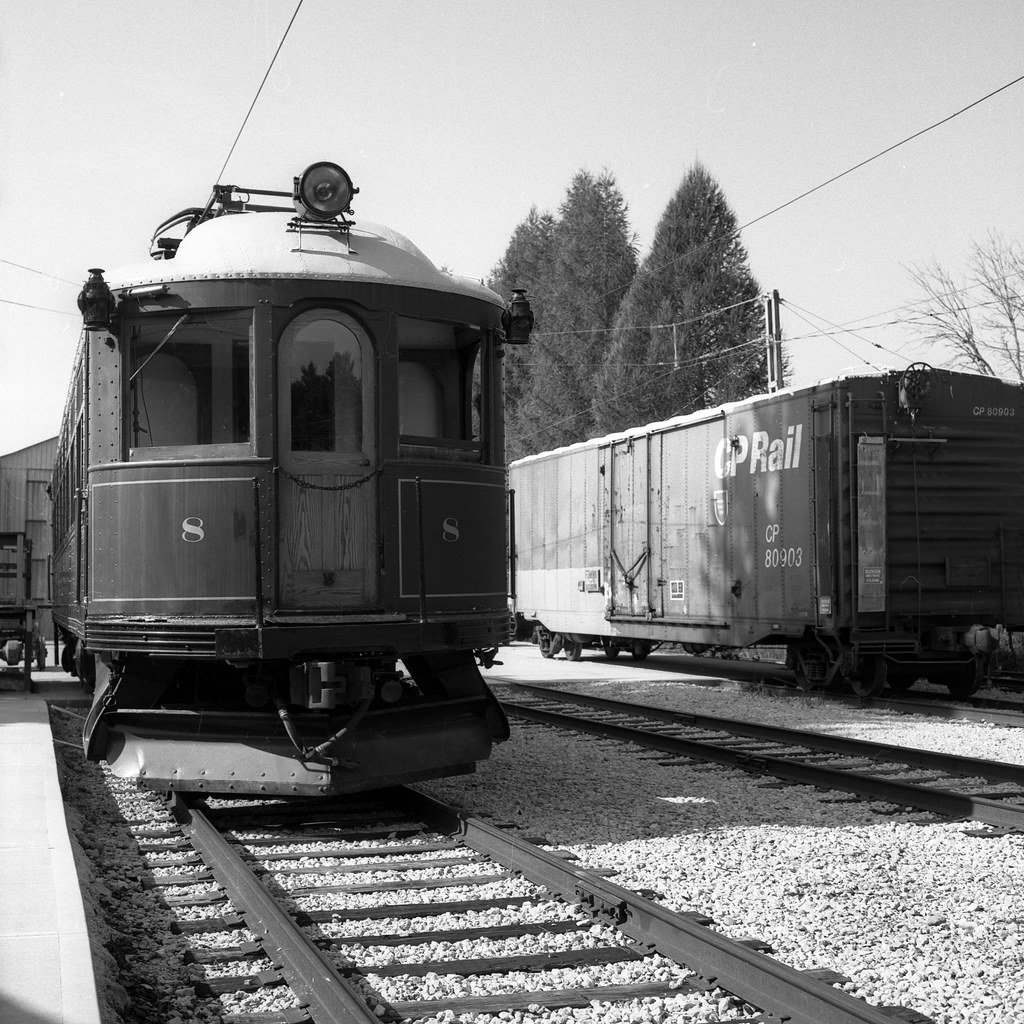I have encountered certain subjects that have proven challenging to find a clear history throughout this project. Then there’s the London & Port Stanley Railroad Port Stanley Station, which has little information online about the history of the building. In contrast, there is plenty of history about the railway but little about the Port Stanley station.

Graflex Crown Graphic – Fuji Fujinon-W 1:5.6/125 – Ilford HP5+ @ ASA-200 – Pyrocat-HD (1+1+100) 9:00 @ 20C
I would not be surprised if you have not heard of the London & Port Stanley Railway. The railway was among the first railways to form in the first railway boom of the 1850s. But it never had any significant publicity because it only ran from London to Port Stanley. It was also the first railroad in Canada to be constructed to Standard Gauge. It never received government money under the Railway Guarantee Act 1849. Freight drove the line between south-western Ontario and Ohio, primarily timber and coal. Wood from Ontario would run down to Port Stanley; the cars were loaded onto a rail ferry and sent across to Ohio, and coal from Ohio would return on the vehicles. While freight remained primary, passenger traffic proved an excellent income source as Port Stanley boosted a rich tourist draw. The sandy beaches and resorts attracted those seeking to escape city life. However, the railway did not earn the best reputation amongst riders. Earning the nickname Late & Poor Service and Lost & Presumed Sunk among the more amusing ones, once the passengers reached Port Stanley, they had a wealth of services promoted by the railway. The station was typical of the day, constructed with a simple rectangular footprint. The station featured a wooden exterior, with a single passenger waiting room, station agent office, ticket window and a protruding telegraph operator bay. The station also featured oversized baggage and freight rooms. The platforms were large, covered, and had excellent seating.
Additionally, a small exterior lunch counter served simple meals to passengers. The railway constructed a large dance hall and other resort buildings for those wishing to vacation at the beach. The history of London & Port Stanely fascinating is that even in the 1870s and 1880s, with Grand Trunk gobbling up their competition, Canadian Southern also expanding their network and Canadian Pacific making severe inroads, London & Port Stanley remained independent.

Nikon D750 – AF-S Nikkor 28-70mm 1:2.8D
Nikon D750 – AF-S Nikkor 28-70mm 1:2.8D
Although the interest in purchasing the line came from an unlikely source, the City of London, in 1914, the city signed a 99-year lease on the line, and Mayor Sir Adam Beck decided to covert the line into an interurban line. At the same time, steam-powered freight trains continued to roll across the tracks. New electrical wires, locomotives, and cars started providing a quick and easy commuter and passenger service between London and Port Stanley. Additionally, more stops were added to the line to serve those better using the line. By the 1920s, the line’s main stations in London, St. Thomas, and Port Stanley received either a total rebuild or an update. History is clear that the St. Thomas station was torn down and rebuilt; it is not clear on Port Stanley. I’m going to assume that the exterior was covered in stucco during this period. The final freight train travelled the line in 1932, leaving the line electrified. London & Port Stanley continued to operate through the war years, but in the mid-century, ridership began to decline as personal automobiles grew in popularity. Despite the city purchasing the entire railway in 1954, the final passenger train drove through in 1957. While the line saw limited use, mainly for tourist excursions, the stations were locked up and abandoned. And eventually, even the tubes were left in place and grown over. The section of track between London and St. Thomas became a part of Canadian National in 1965, and the last surviving building of the beach clubs, the dance pavilion, burned down in 1976.

Nikon D750 – AF-S Nikkor 28-70mm 1:2.8D
Nikon D750 – AF-S Nikkor 28-70mm 1:2.8D
All was not lost; in 1982, a group of local rail history buffs decided to restart operations on the line. The work was far from easy; volunteers had to hack away a couple of decades worth of overgrowth from the rail lines and conduct repairs. Worse was the restoration work on the Port Stanley station. The station received a needed clean-up and facelift, the old rail yard was cleaned out, and new rolling stock was acquired. It took five years’ worth of volunteer labour, but the line from Port Stanley and St. Thomas received the go-ahead, and the Ontario Government issued a short line charter to the new Port Stanley Terminal Railway. Today, the line operates as a tourist line railway between Port Stanley and London, with a stop at the village of Union. They used five locomotives, all mid-century diesel-electric running efficiently on the short line. Passengers ride in comfort in a collection of historic passenger cars, and it is worth a ride to get a feel for the early days of rail. There is also a great deal of London & Port Stanley electric rolling stock preserved at the Halton Radial Railway Museum, Elgin County Railway Museum and the Canadian Railway Museum.

Rolleiflex 2.8F – Carl Zeiss Planar 80mm 1:2.8 – Lomography Potsdam 100 @ ASA-100 – Blazinal (1+50) 9:30 @ 20C